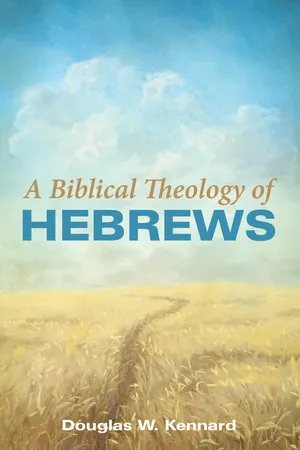
- 186 pages
- English
- ePUB (mobile friendly)
- Available on iOS & Android
A Biblical Theology of Hebrews
About this book
Using a biblical theology method, this book reflects the content of the epistle of Hebrews within its Jewish-Christian context. Within Jewish monotheism, a Two Powers Christology is championed to float a simple missional Trinitarianism. Jesus Christ is also presented as a superior prophet, Davidic king, and Melchizedek priest. Christ initiates the new covenant with his very Jewish atonement in the Day of Atonement pattern, ultimately perfecting believers' conscience (as an Edwardsian Religious Affection) and providing everlasting forgiveness. This provision initiates the believer on a new exodus toward the celestial city within a two-way soteriological framework. To make it to that heavenly goal, the believer must continue in faith. Those who are faithful already begin to experience rest in this life as a foretaste of the kingdom rest to come, when Christ brings in eschatological salvation.
Frequently asked questions
- Essential is ideal for learners and professionals who enjoy exploring a wide range of subjects. Access the Essential Library with 800,000+ trusted titles and best-sellers across business, personal growth, and the humanities. Includes unlimited reading time and Standard Read Aloud voice.
- Complete: Perfect for advanced learners and researchers needing full, unrestricted access. Unlock 1.4M+ books across hundreds of subjects, including academic and specialized titles. The Complete Plan also includes advanced features like Premium Read Aloud and Research Assistant.
Please note we cannot support devices running on iOS 13 and Android 7 or earlier. Learn more about using the app.
Information
Introduction
Table of contents
- Title Page
- Chapter 1: Introduction
- Chapter 2: God
- Chapter 3: Spokesman for God
- Chapter 4: Hebrews’ Epistemology of Prophecy as Rhetorical Proclamation that Christ is Supreme
- Chapter 5: Christ as God-King, Superior to Angels
- Chapter 6: Apostle Jesus, More Glorious than Moses
- Chapter 7: Melchizedek Priest
- Chapter 8: The Law and the New Covenant
- Chapter 9: Christ’s New Covenant Atonement
- Chapter 10: The Narrow Exodus Way of Faith to Salvation
- Chapter 11: Warnings in Hebrews
- Chapter 12: Final Letter Features
- Bibliography